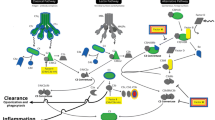Abstract
Intravenous immunoglobulin (IVIG) has shown limited promise so far in human clinical studies on Alzheimer’s disease (AD), yet overwhelmingly positive preclinical work in animals and human brain cultures support the notion that the therapy remains potentially efficacious. Here, we elaborate on IVIG neuropreservation by demonstrating that IVIG protects human primary neurons against oxidative stress in vitro and that IVIG preserves antioxidant defense mechanisms in vivo. Based on these results, we propose the following translational impact: If the dosage and treatment conditions are adequately optimized, then IVIG treatment could play a significant role in preventing and/or delaying the progression of neurodegenerative diseases, such as AD. We suggest that IVIG warrants further investigation to fully exploit its potential as an anti-oxidant, neuroprotective and synapto-protecting agent.





Similar content being viewed by others
References
Schneider LS, Lahiri DK. The perils of Alzheimer’s drug development. Curr Alzheimer Res. 2009;6(1):77–8.
Lahiri DK, Long, JM, Maloney B, Greig NH. Lessons from a BACE1 inhibitor trial: Off-site but not off base. Alzheimers Dement. 2014. doi:10.1016/j.jalz.2013.11.004.
Basha MR, Wei W, Bakheet SA, Benitez N, Siddiqi HK, Ge YW, et al. The fetal basis of amyloidogenesis: exposure to lead and latent overexpression of amyloid precursor protein and beta-amyloid in the aging brain. J Neurosci. 2005;25(4):823–9.
Lahiri DK, Maloney B, Zawia NH. The LEARn model: an epigenetic explanation for idiopathic neurobiological diseases. Mol Psychiatry. 2009;14(11):992–1003. Nature Publishing Group.
Selkoe DJ. SnapShot: pathobiology of Alzheimer’s disease. Cell. 2013;154(2):468–468.e1.
Perez FP, Bose D, Maloney B, Nho K, Shah K, Lahiri DK. Late-onset Alzheimer’s disease (LOAD) heating up and foxed by several proteins: pathomolecular efects of the aging process. J Alzheimer Dis. 2014;40(1):1–17.
Alley GM, Bailey JA, Chen D, Ray B, Puli LK, Tanila H, et al. Memantine lowers amyloid-beta peptide levels in neuronal cultures and in APP/PS1 transgenic mice. J Neurosci Res. 2010;88(1):143–54.
Bailey JA, Lahiri DK. A novel effect of rivastigmine on pre-synaptic proteins and neuronal viability in a neurodegeneration model of fetal rat primary cortical cultures and its implication in Alzheimer’s disease. J Neurochem. 2010;112(4):843–53.
Bailey JA, Ray B, Greig NH, Lahiri DK. Rivastigmine lowers Aβ and increases sAPPalpha levels, which parallel elevated synaptic markers and metabolic activity in degenerating primary rat neurons. PLoS ONE. 2011;6(7):e21954.
Ray B, Chauhan NB, Lahiri DK. Oxidative insults to neurons and synapse are prevented by AGE and SAC treatment in the neuronal culture and APP-Tg mouse model. J Neurochem. 2011;117(3):388–402.
Farlow MR, Brosch JR. Immunotherapy for Alzheimer’s disease. Neurol Clin. 2013;31(3):869–78.
Holmes C, Boche D, Wilkinson D, Yadegarfar G, Hopkins V, Bayer A, et al. Long-term effects ofAbeta42 immunisation in Alzheimer’s disease: follow-up of a randomised, placebo-controlledphase I trial. Lancet. 2008;372:216–23.
Salloway S, Sperling R, Gilman S, Fox NC, Blennow K, Raskind M, et al. A phase 2 multiple ascending dose trial of bapineuzumab in mild to moderate Alzheimer disease. Neurology. 2009;73:2061–70.
Gilman S, Koller M, Black RS, Jenkins L, Griffith SG, Fox NC, et al. Clinical effects of Abeta immunization (AN1792) in patients with AD in an interrupted trial. Neurology. 2005;64:1553–62.
Dodel R, Neff F, Noelker C, Pul R, Du Y, Bacher M, et al. Intravenous immunoglobulins as atreatment for Alzheimer’s disease: rationale and current evidence. Drugs. 2010;70:513–28.
Relkin NR, Szabo P, Adamiak B, Burgut T, Monthe C, Lent RW, et al. 18-Month study ofintravenous immunoglobulin for treatment of mild Alzheimer disease. Neurobiol Aging. 2009;30:1728–36.
http://www.baxter.com/press_room/press_releases/2013/05_07_13_gap_study.html. Accessed 12/15/2013.
Magga J, Puli L, Pihlaja R, et al. Human intravenous immunoglobulin provides protection against Abeta toxicity by multiple mechanisms in a mouse model of Alzheimer’s disease. J Neuroinflammation. 2010;7:90.
Puli L, Pomeshchik Y, Olas K, Malm T, Koistinaho J, Tanila H. Effects of human intravenous immunoglobulin on amyloid pathology and neuroinflammation in a mouse model of Alzheimer’s disease. J Neuroinflammation. 2012;9:105.
Counts S, Perez S, He B, Mufson E. Intravenous immunoglobulin reduces tau pathology and preserves neuroplastic gene expression in the 3xTg mouse model of Alzheimer’s disease. Current Alz Res. 2014; In press.
Sudduth TL, Greenstein A, Wilcock DM. Intracranial injection of Gammagard, a human IVIg, modulates the inflammatory response of the brain and lowers Aβ in APP/PS1 mice along a different time course than anti-Aβ antibodies. J Neurosci. 2013;33(23):9684–92.
Bailey JA, Ray B, Lahiri DK. Intravenous immunoglobulin (IVIG) protects neuronal viability and synaptic markers in cultured degenerating primary hippocampal neurons. Societ Neurosci Abst. 2012;852.04.
Lahiri DK, Ray B. Effect of IVIG in preserving human primary neurons and protecting them against oxidative stress. Alzheimers Dement. 2013;9(4):800.
Lahiri DK, Ray B. Intravenous Immunoglobulin (IVIG) treatment exerts a protective effect against oxidative insults in primary human neuronal mixed cultures. Curr Alzheimer Res. 2014; In press.
Long JM, Ray B, Lahiri DK. MicroRNA-153 physiologically inhibits expression of amyloid-beta precursor protein in cultured human fetal brain cells and is dysregulated in a subset of Alzheimer disease patients. J Biol Chem. 2012;28(37):31298–310.
Counts SE, Che S, Ginsberg SD, Mufson EJ. Gender differences in neurotrophin and glutamate receptor expression in cholinergic nucleus basalis neurons during the progression of Alzheimer’s disease. J Chem Neuroanat. 2011;42:111–7.
Ginsberg SD, Alldred MJ, Counts SE, Cataldo AM, Neve RL, Jiang Y, et al. Microarray analysis of hippocampal CA1 neurons implicates early endosomal dysfunction during Alzheimer’s disease progression. Biol Psychiatry. 2010;68:885–93.
Acknowledgments
We sincerely appreciate the grant support from the Alzheimer’s Association (Zenith award and IIRG; DKL), the NIH (DKL and SEC), Baxter Healthcare (DKL and SEC), and the St. Mary’s Foundation (SEC).
Author information
Authors and Affiliations
Corresponding author
Rights and permissions
About this article
Cite this article
Counts, S.E., Ray, B., Mufson, E.J. et al. Intravenous Immunoglobulin (IVIG) Treatment Exerts Antioxidant and Neuropreservatory Effects in Preclinical Models of Alzheimer’s Disease. J Clin Immunol 34 (Suppl 1), 80–85 (2014). https://doi.org/10.1007/s10875-014-0020-9
Received:
Accepted:
Published:
Issue Date:
DOI: https://doi.org/10.1007/s10875-014-0020-9




